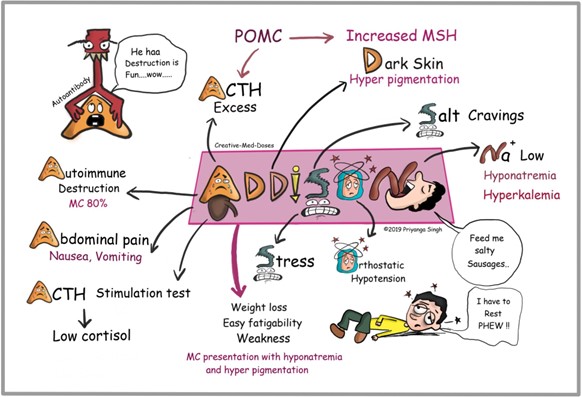A client with Addison's disease becomes weak, confused, and dehydrated following the onset of an acute viral infection. The client's laboratory values include: sodium 129 mEq/L (129 mmol/L), glucose 54 mg/dl (2.97 mmol/L) and potassium 5.3 mEq/L (5.3 mmol/L).
When reporting the findings to the healthcare provider, the nurse anticipates a prescription for which intravenous medication?
Reference Ranges
- Sodium [Reference Range: Adult 136 to 145 mEq/L (136 to 145 mmol/L)
- Glucose (Reference Range: 0 to 50 years: 74 to 106 mg/dl. (4.1 to 5.9 mmol/L))
- Potassium [Reference Range: 3.5 to 5.0 mEq/L (3.5 to 5.0 mmol/L)
Broad spectrum antibiotic.
Regular insulin.
Hydrocortisone.
Potassium chloride.
The Correct Answer is C
The client with Addison's disease is experiencing weakness, confusion, and dehydration, which can be indicative of an adrenal crisis. The low sodium level (129 mEq/L) and low glucose level (54 mg/dl) further support this suspicion. An acute viral infection can trigger an adrenal crisis in individuals with Addison's disease.

Intravenous hydrocortisone, a glucocorticoid, is the treatment of choice for managing an adrenal crisis. It helps to replenish cortisol levels and stabilize the client's condition.
Hydrocortisone helps in restoring the body's stress response and regulating electrolyte and glucose levels.
A broad-spectrum antibiotic may be necessary if there is evidence of a bacterial infection, but it does not directly address the symptoms associated with Addison's disease.
Regular insulin is used for managing high blood glucose levels in conditions such as diabetes, but in this case, the client has low glucose levels, so insulin is not the appropriate intervention.
Potassium chloride is a medication used to treat low potassium levels (hypokalemia), but the client's potassium level is within the reference range (5.3 mEq/L). Therefore, potassium chloride is not indicated in this situation.
Nursing Test Bank
Naxlex Comprehensive Predictor Exams
Related Questions
Correct Answer is C
Explanation
Given the client's difficulty with memory, concentration, and recent life changes, it is
important for the nurse to acknowledge the possibility of delirium as a potential cause of the client's symptoms. Delirium is an acute state of confusion that can be caused by various factors, including physical illness, medication side effects, and emotional stressors. It is often reversible when the underlying cause is identified and treated.
By mentioning the possibility of delirium and its potential reversibility, the nurse opens up the conversation to exploring other factors that may be contributing to the client's symptoms. This response also provides hope to the family by suggesting that the client's condition may improve with appropriate interventions and management.
Stating that dementia resulting from Alzheimer's disease is often reversible even in the late stages is incorrect. Alzheimer's disease is a progressive neurodegenerative disorder that currently has no cure, and the symptoms tend to worsen over time.
Reversibility is not typically associated with Alzheimer's disease.
Indicating that the client's symptoms of dementia are permanent due to age is a generalization and may not be accurate. While age is a risk factor for certain types of dementia, such as Alzheimer's disease, it does not mean that all memory and cognitive difficulties in older adults are irreversible.
Suggesting that delirium is often a sign of underlying mental illness and institutionalization is necessary is not appropriate. Delirium is a medical condition that requires thorough assessment and appropriate management, including addressing any underlying causes. Institutionalization may be considered in certain situations, but it is not the primary focus of communication in this context.
Correct Answer is D
Explanation
Acute kidney injury (AKI) can have significant impacts on the client's fluid and electrolyte balance. Mannitol, a diuretic, is commonly used to promote diuresis and increase urine
output in cases of AKI. However, it is essential to assess the client's hemodynamic status and overall condition before administering mannitol.
Obtaining vital signs (such as blood pressure, heart rate, respiratory rate, and temperature) helps evaluate the client's baseline status and monitor for any changes that may occur after administering mannitol. It is particularly important to assess blood pressure as mannitol can potentially cause hypotension as a side effect.
Assessing breath sounds is also crucial because pulmonary edema can occur as a complication of AKI. Mannitol administration may exacerbate this condition. Therefore, assessing breath sounds allows the nurse to monitor for signs of fluid overload, such as crackles or wheezes.
Collecting a clean catch urine specimen may be necessary for diagnostic purposes to assess kidney function and determine the presence or severity of acute kidney injury. However, obtaining vital signs and assessing breath sounds should be the first nursing intervention before administering any medication, including mannitol, to ensure the client's safety and monitor for any potential adverse effects.
Whether you are a student looking to ace your exams or a practicing nurse seeking to enhance your expertise , our nursing education contents will empower you with the confidence and competence to make a difference in the lives of patients and become a respected leader in the healthcare field.
Visit Naxlex, invest in your future and unlock endless possibilities with our unparalleled nursing education contents today
Report Wrong Answer on the Current Question
Do you disagree with the answer? If yes, what is your expected answer? Explain.
Kindly be descriptive with the issue you are facing.
